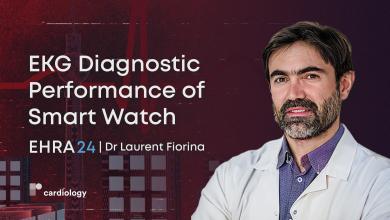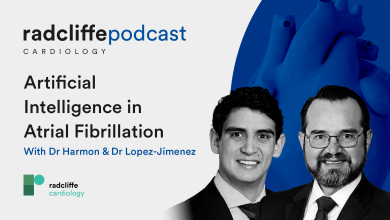Search results
Author(s):
Klaus Bonaventura
,
Ernst Wellnhofer
,
Eckart Fleck
Added:
3 years ago
Electrocardiograms (ECGs), derived by the transformation of three bipolar quasi-orthogonal leads, have according to EASI lead ECG been introduced for many years for use in emergency situations and for the monitoring of patients during the acute phase of myocardial infarction. Theoretically, a further reduction and simplification of the classic EASI setting of five electrodes may even improve…
View more
Author(s):
Syed Khurram Mushtaq Gardezi
Added:
3 years ago
Today, in cardiology, acute coronary syndrome (ACS) is one of the most common presentations in hospitals. Usually, the history and presenting features of ACS are very typical. However, some patients have an atypical presentation, which can pose a problem for prompt diagnosis and management, leading to an overall increase in morbidity and mortality in such patients.
Case Presentation
A 61-year…
View more
Author(s):
John GF Cleland
,
David Barrett
Added:
3 years ago
Health services in the developed world are faced with unprecedented challenges over the coming years. The ageing population and increased prevalence of long-term conditions have been factors for some time, but the pressure on resources has been exacerbated by the economic turmoil of recent years.
Increasing healthcare costs and expectations, coupled with the growing need for restraint in…
View more
Author(s):
Felix Gramley
,
Andreas Goette
Added:
3 years ago
Heart disease is the leading cause of death in the US, with sudden cardiac death (SCD) accounting for most of these fatalities.1 Considering the growing prevalence of coronary heart disease and cardiomyopathies (see Figure 1) that, taken together, cause most SCDs, effective treatments are needed. Since by definition SCD is ‘sudden’ (generally accepted to be within one hour after onset of symptoms…
View more
Author(s):
Laurent Fiorina
Added:
18 hours ago
EHRA 24 - In this short interview, we are joined by Dr Laurent Fiorina (Cardiovascular Institute Paris-Sud (ICPS), FR) joins us to discuss the findings from a clinical investigation into the EKG Diagnostic Performance of the Apple Watch Augmented With an AI Algorithm (NCT05045456).This observational, prospective clinical trial aims to investigate the performance of an artificial intelligence…
View more
Author(s):
Velislav N Batchvarov
Added:
3 years ago
Introduction
The Brugada syndrome (BrS) is a hereditary arrhythmia syndrome manifesting as recurrent syncope or sudden cardiac death (SCD) due to polymorphic ventricular (VT) or fibrillation (VF) in the absence of overt structural heart disease or myocardial ischaemia.1,2 The prevalence of the syndrome is estimated at around 15 per 10,000 in South East Asia including Japan and around 2 per 10,000…
View more
Author(s):
Nico Bruining
Added:
3 years ago
With the continuous growth of computer networks in hospitals and, more importantly, the possibilities for contacting other hospitals and healthcare providers by high-speed internet, plus the demand for faster diagnosis and cost-reductions, the interest for tele-medicine is increasing. The definition of tele-cardiology is: “the use of cardiovascular information exchanged from one site to another…
View more
Author(s):
Francisco Lopez-Jimenez
,
David M Harmon
Added:
11 months ago
In this episode from the Radcliffe Podcast, Dr Francisco Lopez-Jimenez (Mayo Clinic, US) and Dr David Harmon (Mayo Clinic, US) join us to discuss the future of AI in Atrial Fibrillation treatment, based on Dr Harmon's recently published article in AER Journal; 'Artificial intelligence for the detection and treatment of atrial fibrillation'.
Dr Lopez-Jimenez and Dr Harmon discuss the…
View more
Author(s):
Akira Matsumori
Added:
1 year ago
Author(s):
Uchenna Ozo
,
Sanjay Sharma
Added:
3 years ago
Athletes may occasionally succumb to sudden cardiac arrest because of a quiescent cardiac abnormality. These catastrophes are rare, affecting between 1 in 17,000 to 1 in 50,000 athletes, depending on the sporting discipline.1,2 Most deaths affect male athletes participating in explosive sports of a start–stop nature, such as basketball and soccer, and occur during or immediately after exercise.1…
View more














